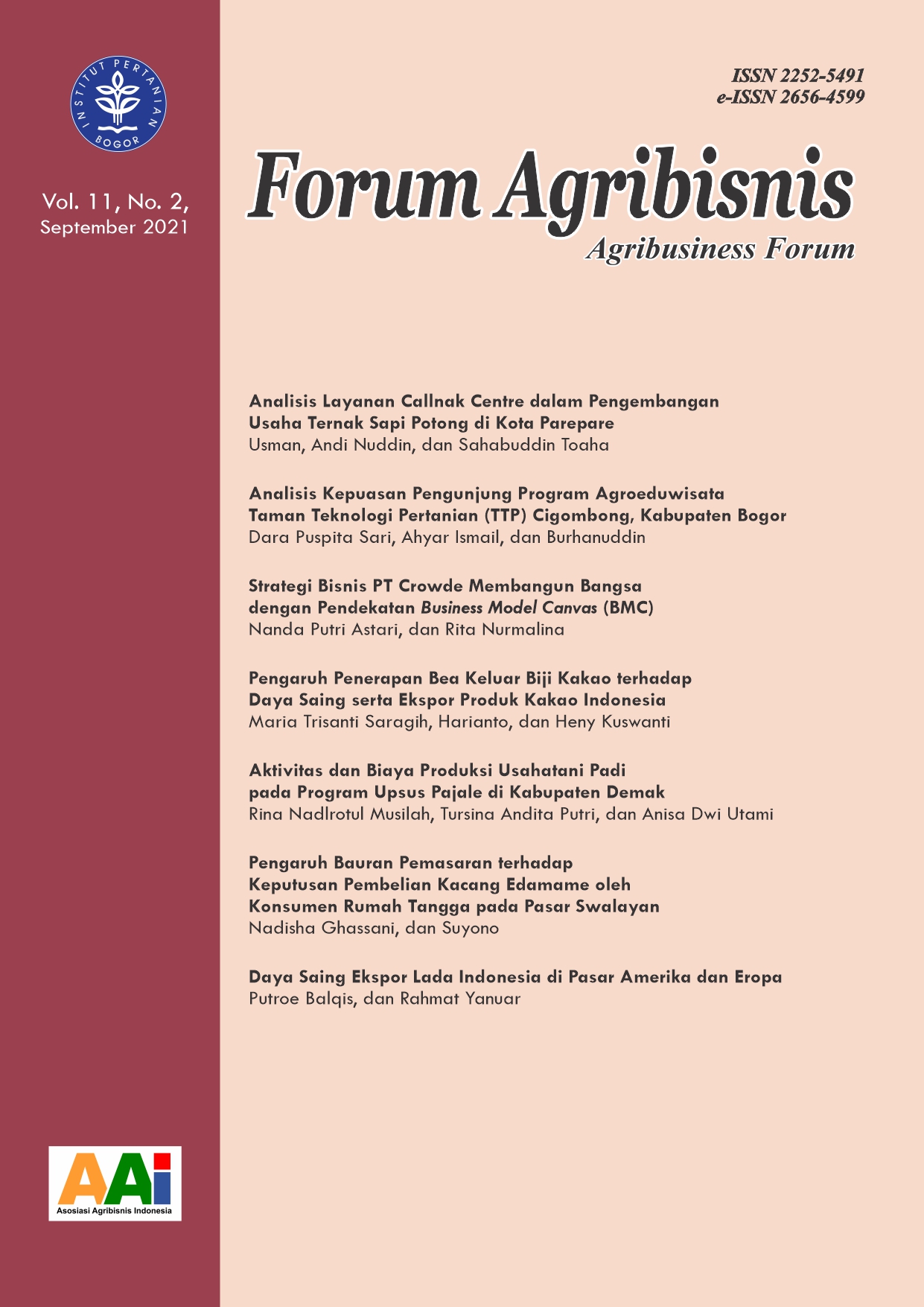Strategi Bisnis PT Crowde Membangun Bangsa dengan Pendekatan Business Model Canvas (BMC)
Main Article Content
Abstract
PT Crowde Membangun Bangsa is a financial technology company that offers capital services for agricultural activities. With the concept of peer-to-peer lending (P2P), the company functions as a platform are to bring investors and customers together. To continue to grow and face competition in the future, PT Crowde Membangun Bangsa requires preparation and improvement of business models. This study aims to (1) map the business model applied at PT Crowde Membangun Bangsa, (2) Identify strengths, weaknesses, opportunities, and threats of the nine elements of the Business Model Canvas of PT Crowde Membangun Bangsa, (3) Formulate alternative Business Model strategies The right canvas to be applied to PT Crowde Membangun Bangsa. The data collection method is carried out by direct observation and using the qualitative method. The conclusion of this study is the improvement in the new Business Model Canvas, especially in the customer segment elements by adding plantations as a new segment and beef cattle commodity as an improvement to existing segments so that the company's targets are met. Improvements in these elements need to be supported by improvements from other elements, namely reactivating individual investors as additional corporate financial key resources and types of loan facilities to increase the value proposition and optimizing the use of technology in customer relationship elements and key activities so that additional consumer segments are followed by maximum service and efficient key activities.
Downloads
Article Details

This work is licensed under a Creative Commons Attribution-ShareAlike 4.0 International License.
The author submitting the manuscript must understand and agree that the copyright of the article manuscript must be submitted/transferred to the Journal Forum Agribisnis. This work is licensed under the Creative Commons Attribution-ShareAlike 4.0 (CC BY-SA) International License in which the Author and Reader can copy and redistribute the material in any media or format, and remix, modify and build material for any purpose, but they must provide appropriate credit (citing articles or content), provide a link to the license, and indicate whether there is a change. If you mix, change, or create material, you must distribute your contribution under the same license as the original.
References
Chesbrough, HW. 2006. Open Business Models: How to Thrive in The New Innovation Landscape. Boston: Harvard Business School Press.
[DSR]. Daily Social Report. 2020. Pendanaan Start up Berdasarkan Sektor Bisnis, 2019. [Internet]. [diunduh 2020 Februari 18]. Tersedia pada : https://dailysocial.id/post/pendanaan-startup-indonesia-2019. Oster
Datt G, Ravallion M. 1996. How Important to India’s Poor is the Sectoral Composition of Economic Growth?: The World Bank Economic Review.
David FR. 2016. Manajemen Strategik. Ed ke-15. Puspasari LN, penerjemah, Jakarta (ID) : Salemba Empat. Terjemahan dari : Stretegic Manajemen : A Competitive Advantage Approach, Concept and Cases, 15th ed.
Disa AA, Nurmalina R, Syuaib MF. 2015. Analysis of Business Model Development of Honey Product Using Business Model Canvas Approach. International Journal of Science and Research (IJSR). 6 (8): 262-267.
Kharisma B, Nur YH. 2019. Penentuan komoditas perkebunan unggulan di provinsi jawa barat. Jurnal trunojoyo. 14 (1): 73-104
Kosasi, VM. 2015. Analisis dan Evaluasi Model Bisnis pada Pantai Seafood Restaurat dengan Pendekatan Business Model Canvas. AGORA. 3(1): 314-323.
Luthan MZ, Winandi R, Rifin A. 2019. Analisis Pengembangan Bisnis Kanvas Perusahaan Holtikultura PT XYZ. Forum Agribisnis. 9(2): 185-199.
Matsuyama K. 1992. Agriculture Productivity, Comparative Advantage and Economic Growth: Journal of Economic Theory.
Osterwalder A, Pigneur Y. 2019. Business Model Canvas. Ed ke-10. Natalia RS, penerjemah. Jakarta (ID) : Gramedia. Terjemahan dari : Business Model Canvas, 10th ed.
Permadi B, Nurmalina R, Kirbrandoko. 2016. Analisis pengembangan Model Bisnis Kanvas CV Kandura Keramik Bandung. Jurnal Aplikasi Manajemen. 14 (1):88-96.
Pasaribu B. 2006. Poverty Profile and Alleviation Programs in Indonesia. Paper presented in Asian Regional Seminar on Poverty Alleviation, held by AFPPD and IFAD. Hanoi, Vietnam.
Rukka RM, Busthanul N, Antonny N. 2018. Startegi Pengembangan Bisnis Keripik Bayam dengan Pendekatan Business Model Canvas : Studi kasus pada CV. OAG di Kota Makassar, Sulawesi Selatan. Jurnal Sosial Ekonomi Pertanian. 14(1):41-54
Wati DR. 2015. Akses kredit mikro pada petani padi organic di kabupaten bogor. Jurnal agribisnis. 9 (2): 97-110.
Yudhoyono SB. 2004. Pembangunan Pertanian dan Perdesaan Sebagai Upaya Mengatasi Kemiskinan dan Pengangguran: Analisis EkonomiPolitik Kebijakan Fiskal [Disertasi]. IEPIPB. Bogor.

